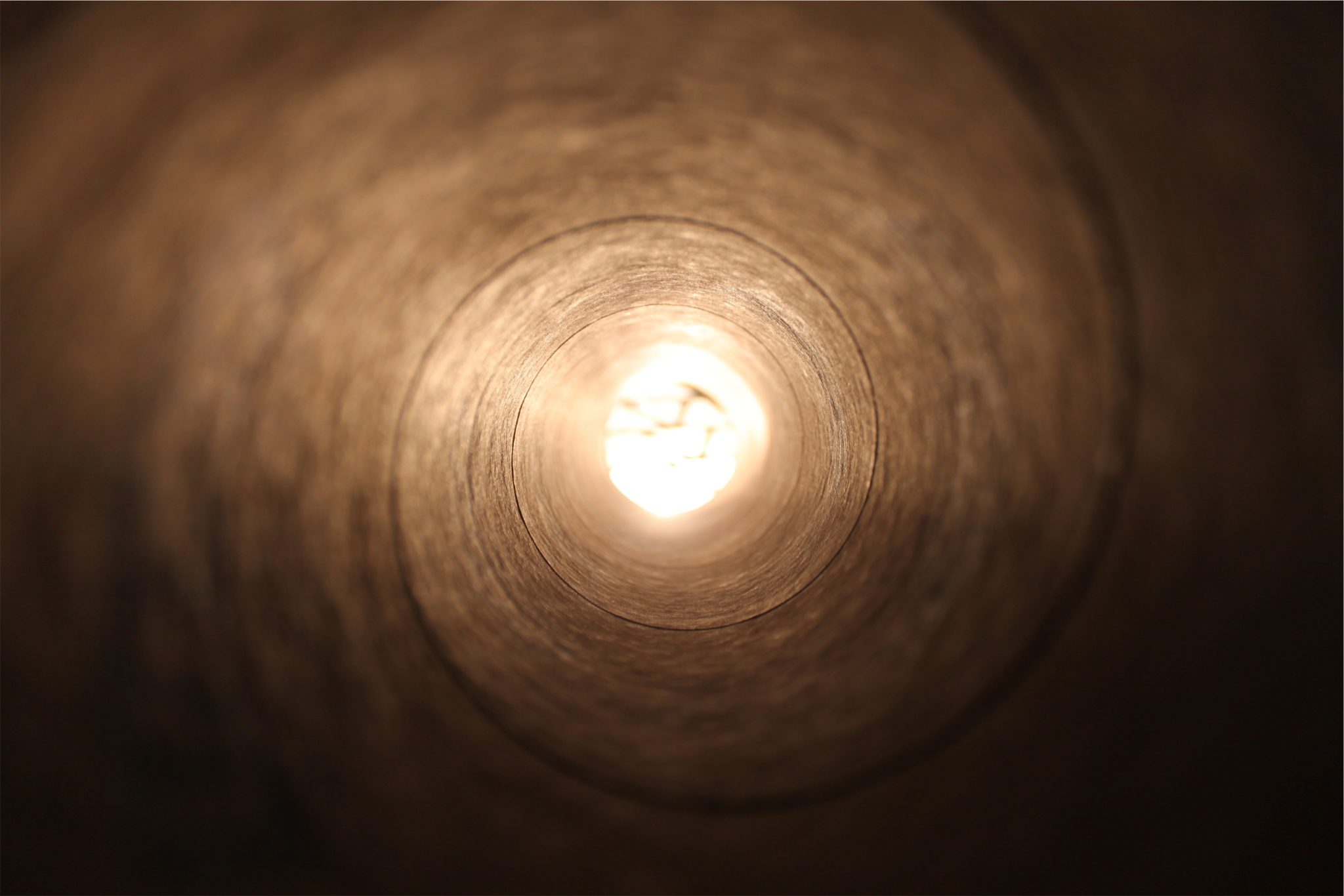The visual imagery that you painted in last week’s article provides an excellent palette for artists. I am an artist inspired by the inner mystical infrastructure that shaped everything around us, and I am still mulling over your words. I sense that they carry many fundamental elements necessary in seeing the world as it is, beneath its surface skeleton.
What really struck me was the image of the “square robe.” It brought to mind Rothko’s “blocks” or “squares” – the way he depicted existence at its core, once deconstructed.
But I was wondering whether you could clarify one key point. Though hardly a connoisseur, I have dabbled in Kabbalah here and there, and recall learning about the concept of the “great circle” (iggul hagodol). In the words of the Ari (Rabbi Isaac Luria): The Divine infinite light filled all of existence, not allowing “space” for anything outside itself. Only the Tzimtzum – the total concealment of the Divine light – made room for our independent reality to emerge. I quote an English translation of the Etz Chaim:
“And behold, this contraction was equally balanced around that middle empty point in such a manner that the vacuum was circular, an even circle, in complete balance and sameness all around, with no square angular protrusions. It was not in the shape of a cube, which has straight angles, since the Infinite also withdrew His Light in a circular form equally on all sides. The reason for this is that the Infinite Light was symmetrical with a complete symmetry, so that it felt compelled to contract itself equally on all sides.
It is a well-known fact that geometrically, a sphere or circle is the most balanced and uniform figure. There is no figure of such symmetry as the circle, certainly not the rectangle, with angles jutting out, nor the triangle, nor any other figure. It was therefore necessary for the middle point to be contracted in the form of a circle. In the Zohar Parashah Bo, “a vessel in the circle which is Yod” [see also Parashath Pekudei of R. Nachman where it is stated that the hall and their contents are circular].
There is a further reason: for the sake of the emanations that in the future will come forth in the place of that empty void space. The point is that the circular emanations are all equally “close” to the Infinite, which completely and evenly encircles them, and the light and abundance that they require are drawn equally from all sides of the Infinite. This would not be so if the emanation were square or triangular or any other shape, for if one side or angle protruded beyond the others, they could not receive the Infinite Light equally.”
The Ari unequivocally insists that the “space” left by the tzimtzum was specifically a “circle” and not a “cube,” in order to allow for a symmetric distribution of light. How do we then reconcile this deliberate “circle” with the concept of the “square robe?”
Noam
Dear Noam,
What can I say? Your question goes right to the heart of the complex metaphysical engineering of existence.
In an attempt to unravel and decipher these fundamental dynamics, it may be best to begin from the “bottom,” from the practical and psychological application of these ideas, and from there work our way up to the more abstract dimensions of these concepts.
Some people are like squares. Others like circles. Webster defines a square as “a person who is conventional or conservative in taste or way of life.” But we use the term today far more liberally. A “square” is often used in a derogatory way – oh, that guy is so square – signifying a person who is very linear and limited and cannot see “out of the box;” one who is bound by structured rules and schedules, and disturbed by anything spontaneous, different or fresh.
The circle, by contrast, is a personality that thrives on the abstract and intangible. “Circular” personalities are exciting, spontaneous, flexible. But they are also not necessarily grounded. Like a circle, you never know where they stand. For all the monotony of a “square,” you can depend on him. His coordinates are defined and you can identify where he stands at any given location and time. A circle, on the other hand, has no beginning and no end, no top and no bottom.
In the world of colors, the square is black and white, perhaps even a bit gray. The circle is colorful, kaleidoscopic, ever-changing.
Our great dream is to find a spouse or a friend who has the best of both worlds. Reliable, steady, solid. A straight shooter. Yet also fun, enchanting, adventurous. But is that possible? Can ever the twain meet? Aren’t the two personality types diametric opposites? The straight line – the square – is reliable and consistent precisely because he is a square. And the spontaneous one is that way precisely because he is circular. How then can we expect to fuse them together?
Circle and square define much more than personality types. Many foundational principles of life can be understood and appreciated in terms of circle and square.
Eastern and Western thought, for instance, can be distinguished, in certain ways, as the difference between “circular” thinking and “linear” (square) thinking. A strong feature of Western philosophy lies in its elegant structure, driven by rigid logic. This mathematical structure stands in stark contrast to Eastern philosophies, where logic and definitions are actually dissuaded. In many schools of Eastern thought the search for truth and reality is to be found not in our mortal attempts at making sense of the universe with our limited minds and our myopic rules, trying to fit things into our convenient “boxes,” filing them into organized “files,” forcing knowledge and discovery to fit into our “comfort zones.” It is to be found by transcending – by getting beyond – our logical tools and experiencing a higher reality, where we become at peace with paradox.
Both sides of the brain can also be compared to the square and the circle. The left-brain processes experiences as localized events, itemized, detail by detail. The right-brain thinks in terms of everything being part of a unified field of energy.
In science too, Newtonian physics is often compared to the “billiard ball effect.” The laws of the nature work like clockwork, absolutely predictable and deterministic. No matter how many times you hit a billiard ball, if you do so each time in the same exact way, with the exact same speed, angle and motion, its effect will always be the same. Quantum mechanics, on the other hand, is “ruled” by states of “probability” instead of “certainty,” laws of “indeterminacy,” principles of “uncertainty” (which disturbed Einstein, who dismissed it as “spooky action at a distant” and saying “God doesn’t play dice with the universe”). And not because we lack data about the microscopic world of sub-atomic particles; but because fundamentally, as counter-intuitive as it may be, on a quantum level the “system” does not work as an organized, structured “system” at all, but rather as an “undefined” state of “probability.”
“Square” thinking distinguishes between a subject and an object, an observer and that which is being observed. “Circle” thinking sees them as one, an underlying unity connecting all the dots.
So, the big question is which is the right approach? Both have legitimacy, both work, both have helped us develop extraordinary technologies. And if both have their virtues and both are necessary, how can such two opposites ever meet?
Just as the question looms about relationships, whether we can find a person with both ”circle” and “square” qualities, the same can be asked about East and West, left and right, classic and quantum physics, defined pieces or one unified whole, and many other applications.
Was Kipling right when he wrote: “Oh, East is East, and West is West, and never the twain shall meet”? Or can the two meet?
This week’s Torah portion presents us with a powerful answer.
* * *
The chapter begins with Moses sending scouts to check out the Promised Land. They return with a terrible report, driving fear into the entire nation.
The scouts were circular souls. As free spirits, they were unwilling to enter a mundane land, where they would have to toil and labor in an overwhelming material world, a “land that consumes its inhabitants.” Instead, they preferred to remain in their spiritual “oasis,” Divinely protected in the wilderness from all the harsh elements.
They were, of course, gravely mistaken, and their sin brought on severe consequences that persist to this very day. But there error was not in their intentions; they were driven by the “circular” energy of spirit, which in itself is noble and sublime. However, it was also selfish. The purpose of existence is not to remain in the lofty worlds of circles and spheres, but for the soul to descend into the “square” and defined universe, a material world of structure, governed by the linear elements of time and space. The purpose of all life is to infuse this “square” world with the boundless spirit of the “circle.”
Thus, we have our answer: It is indeed possible – and actually necessary – to integrate the “circle” and the “square.” Only when they join together can we fulfill our calling.
Now, let us return to the metaphysical “circle” and “square.”
In its core root these two archetypes and two central approaches to life originate and were formed by two spiritual gradations in the earliest primordial stages of the cosmic order.
As the Zohar writes (I 5b) about a “circle and square,” which refers to two dimensions of Divine energy: One called “iggulim” (spheres) – an all encompassing energy, the “infinite light,” which, like a circle, is boundless. Its purpose is to maintain the Divine integrity of existence, and infuse in us a sense of awe and “bittul” (modesty, humility), which opens us up to reach beyond our own limited self-interest and allows us to assimilate a perspective beyond our own limited faculties.
The second is called “yosher” (straight line) – a specific, finite energy, which defines the parameters of existence. Its role is to give us individuality, shape our defined personalities and allow for any deeper experience to be fully integrated into our beings (and not annihilate them). For more on this see 0’s and 1’s.
Initially, as the Etz Chaim explains, an indivisible Infinite light permeated all. Unity prevailed. To make room for an independent consciousness, the tzimtzum concealed the Divine light, creating a “space,” a vacuum. We thus have the first ”great circle” (the iggul hagodol) – the light that symmetrically surrounds the “space” within. This “great circle” is the root of all the “circles” to come, and all the “circles” of our life experience. Into this “black hole” would then enter a “narrow line and thread” (kav v’chut) of light, originating from the “circle of light.” This “line and thread” (yosher) is the root of all “square” structures in existence.
But the plot thickens.
In the teachings of the Arizal two types of tzimtzum are discussed. One, the “circular” tzimtzum elucidated in Etz Chaim. This tzimtzum is purposely and explicitly in the form of a circle, and not a cube/square. The reason was cited earlier, in order to maintain an equally distributed connection to the Infinite energy.
But there is another tzimtzum in the form of a “square.” This lesser known tzimtzum is discussed in Emek Hamelech (quoted last week’s article), who describes it as the “square garment.” Its function is to “dress up” the “thin line and thread” and set into motion the “finite” structures (see Vayehi Bensoyah Ha’aron 5669. Ha’oiseh Sukosei 5674).
Which is ultimately more important, the square or the circle, and which is higher?
Rabbi Aaron Halevi, the great student of the Alter Rebbe, explains that the “square” tzimtzum preceded the “circular” one, in order to establish the power of the finite. But in most other places, and the Emek Hamelech himself explains that the “circle” tzimtzum is first, allowing for the “space” of existence in general, followed by the “square” tzimtzum.
These two approaches can be reconciled by the Tzemech Tzedek’s explanation, that there are two orders and images: One of a square within a circle, and the other of a circle within a square (Ohr HaTorah Berocho pp. 1845. See also Biurei HaZohar 52a — explaining Zohar II 180a).
In simpler terms perhaps this can be explained as follows: These two orders reflect two different approaches to the ultimate integration of the finite and the infinite, as well as determining which is ultimately the more important dimension. According to the interpretation that the square precedes the circle, the primary focus is on the finite square, on the structure of existence. As explained in other discourses, that the source of the finite is higher than the source of the infinite. The second approach, however, places more emphasis on the circle and the bittul it elicits, with the finite square being a secondary element.
To take this a step further: Perhaps there are circumstances when the main focus has to be on the “square”, and in other instances when the converse is true.
However, regardless which is primary (and whether the circle is to be included in the square or the other way around), what is absolutely clear is that we are charged with integrating both elements – the “square” and the “circle: The circle is needed to transcend and experience the infinite. The square is needed to ground the process in the finite structure.
This is the reason why last week’s chapter, which describes how the Holy Ark led and protected the people during their journey in the harsh wilderness, is bracketed between the two letters nun. In the world of the finite, as it evolves into the harsh “wilderness,” we need both elements to protect us: The “circle” dimension as well as the protection of the “square garment.”
The scouts clearly did not learn the lesson from this “square garment” in the previous chapter. They only embraced the fact that the Ark protected them, the ”circle” dimension, neglecting to appreciate that equally important is grounding the “circle” in the parameters of life on earth.
To conclude on a practical note: Whether you are more “square-like” or more “circle-like,” both personalities are necessary, and both complement each other.
The question remains: How is it possible to synthesize such two opposites?
And perhaps even more pertinent: Can a circle marry a square?
To be continued next week.








In his book entitled THE ENEMY WITHIN, the author declared that it is safe to say rationally, juducially, and with conviction; that the horrible persecutions on the children of Israel was, and still is, a sybthesis of two factors: Inflexible Religion and Cosmopolitism. To define it in a nut shell: A combination of these two factors enabled the murderers to annihilate the children of Israel in the European Diaspora–which could have been avoided by investing all efforts to thrive to return to the Land of Israel–which they banished from by barbarian heathens,and wait not for unnatural miracles.
The nature of God is that of a circle,
the middle of which is everywhere, and the circumference of which is nowhere.
Empedoclese
Shalom. Integration of the attributes of the square & circle constitute a whole reality,
although seemingly diametrically opposed. An ideal marriage consists of two
halfs uniting as one, one contributing square, and one circular elements.
Separately, the square remains in a box, the circle in the cosmos. Two squares constitute one square reality, two circles, one circular reality. Perhaps a suitable metaphor is, squares are the grasses of the field, circles are the rain enabling growth.
After reading your article, I also ask myself if a square can marry a circle. This is the definition of my marriage my husband is represented as a square personality and I am represented like the circle one. It sure is difficult to have the relationship work, but I have to say there is always one that has to give in order to have a square fit in a circle a vise versa
http://www.avakesh.com/2009/06/chonis-circle.html
As a marriage and relationship coach, I see this kind of dynamic in a lot of relationships. On the premise that marriage and relationships serve as our teacher, usually the prescription is that both parties need to take a step towards each other, towards the sacred space of the relationship, where each has to grow a bit – meaning, one person has to lighten up and one has to tighten up.
Epictetus, a Greek philosopher said:
The nature of God is that of a circle,
the center of which is everywhere, and the circumference of which is nowhere.
To me, the most important lesson learned from this is that two opposites are really part of the same whole; after all, the whole is our true reality, while the differences are projections of our individual realities through communication and relationships. Light cannot be there without darkness nor hot can be there without cold, etc. We should not concern ourselves with our differences but with our similarities, because, in general we indulge in our differences; this way we learn to balance our minds, see our similarities, and love and accept each other.
In our essence we are all one, it is only through our minds and attitudes that we are separated. Without it however, we would have no relationship with each other; because, of our differences we can learn to unite, and this is why we have an experience we call life.
The Kabbalah wasn’t meant for everyone; to fully understand it intelligence is not enough; one has to be able to think outside the box, and this ability is earned through spiritual cultivation.